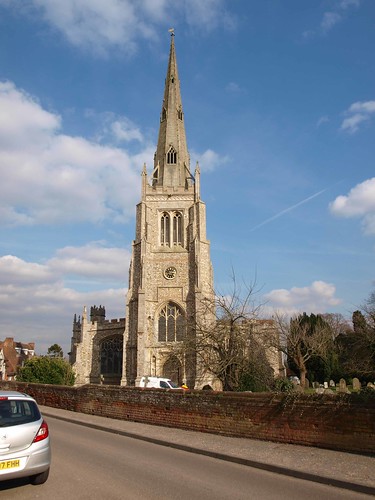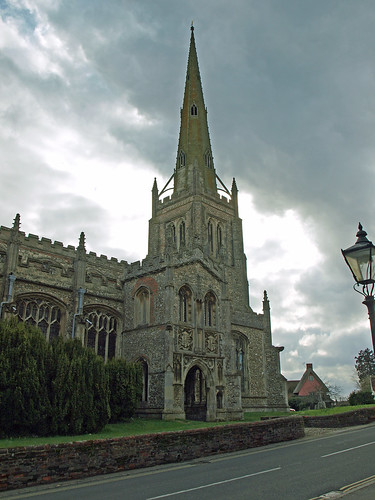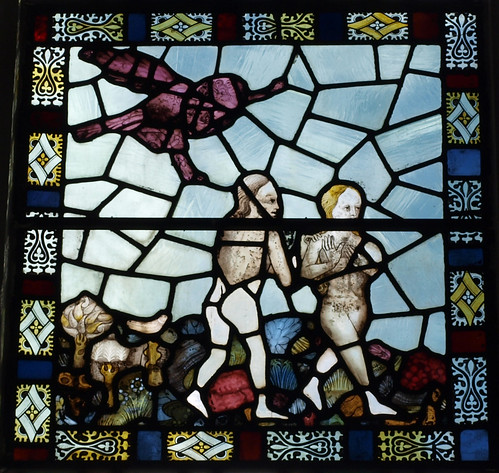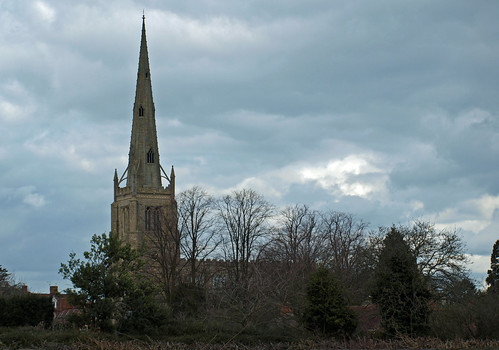A church existed on the site of the chancel before the present Thaxted Church was built; evidence of the earlier building was uncovered at the beginning of the 19th century, but now only one small fragment remains exposed.
In 1270 Roger Niger, Bishop of London compelled the Cistercian monks of Tilty to endow a vicarage so that Thaxted might be served by its own resident priest, but it was not long before the monks were objecting to the payent of tithes for the maintenance of a secuar priest. In 1314 the Thaxted vicar, William, sued them in the Bishops Court; the monks appealed to Rome and the case went against William who, threatened with excommunication, gave up the fight. From then on all contact with the monks at Tilty ceased and maybe the independence this engendered stimulated the parish in its determination to build Thaxted Church as we see it today.
During the 13th and 14th centuries the Guild of Cutlers was a considerable influence and the impact of their industry contributed to the prosperity of the town. In such a lively setting ambitious plans for a new church developed, four churchwardens were appointed to organise and superintend the work, to keep accounts and attend to finance. Many donations of land and property were received and work began in 1340.
Building was undertaken in stages and it has been suggested that the main body of the church developed whilst the old church still stood on the present chancel site. Since it took 170 years to complete and since so many different influences were brought to bear over such a long period, the first builders could not have known what the finished building would look like. Yet their faith in its future must have been strong for the site they chose, the space allocated and the grandeur of design seen in the earliest work heralded an imposing structure of outstanding beauty.
Such a building would not have been possible however without the added help of the descendents of Richard FitzGilbert who, following the Conquest of 1066 was given the Honour of Clare which included the Manor of Thaxted. Edmund Mortimer Earl of March and Ulster, Roger his son, Edmund his grandson and through his granddaughter, Richard Duke of York and Edward IV were all associated with building Thaxted Church. Their connection is still demonstrated today by the presence of carvings in the church, the Falcon for the House of York, the Golden Spread Eagle, an emblem used by Edward IV, the Griffin and the Lion for Mortimer, the Bull for the House of Clare.
Maintaining a building 183 feet long and 87 feet wide, with a magnificent spire which rises to 181 feet is an enormous task. Storms in the 18th and 19th centuries left their mark, but all who have been associated with the building up to the present time recognise that restoration must be a continuous process.
PEVSNER.
THAXTED. The spire of its glorious church guides us from far away, and, no matter which of many roads we take, we are sure to pass some timbered farm before we come to Thaxted’s own array of timbered houses, the homes of the cutlers and the wool workers who made this town prosperous in the Middle Ages. For 500 years their Guildhall has been dominating this wide market street, its black and white storeys propped on wooden posts and supported by cross-beams meeting in a great central pillar. All the ground floor is open except where an old lock-up for unruly fellows now houses two massive hooked poles for pulling thatch from burning cottages. In the panelled room above sat the town council in the days of Elizabeth. Close to the Guildhall are many 15th century neighbours, and the Recorder’s House a little down the street, two of its bay windows resting on oak coving carved with royal arms. On the way to Broxted is the great Tudor Horham Hall. At the Guildhall the wide street divides, one half to end in a fieldpath to the windmill, the other taking us up the hill to the church.
It is one of the grandest churches in the county, 183 feet long and 87 wide, and so beautiful that it may well claim to be the Cathedral of Essex. Begun about 1340, its growth continued through our great building centuries till the Reformation, and the result is a proud example of English architecture. Perfect balance is achieved with the aisles and transepts, chapels and the two porches, the King’s and the Duke’s, for Edward the Fourth gave the one with his arms on it, and the Duke of Clarence gave the other marked with his coronet. Both porches are vaulted, and both have a spiral stair leading to a room above and ending in a turret. The north porch room has been turned into a quiet retreat with three charming coloured plaques on the wall by Phoebe Stabler.
It seems to us a fitting thing that a church so beautiful should be guarded by many old doors; there are six about 500 years old and another a century younger. It is the 400-year-old by which we enter, two of the 500-year-old ones are in the priest’s doorways in the chapels, and the other four lead us up the spiral stairways and into the rooms over the porches.
The grandeur of the church outside is in its richly traceried windows, the spire and the tower with flying buttresses, and the many panelled buttresses with pinnacles and gargoyles; inside is the pure beauty of birch wood. Two gable crosses are carved with the figure of Christ. The lovely arcades with their host of corbel heads rise to clerestory windows set behind exquisite 16th century panelling, and spandrels of pierced stone give a rare beauty to the chancel. Every main arch has its special beauty. Our eyes are drawn first to the 15th century one, which helps to support the rich stone vaulting of the tower, then to the figures above the transept arches, where St Catherine appears between two wheels on one of the capitals.
In each transept a medieval wheel window admits light from over the chapel roofs, and in the chapels the wide window splays come down to enclose stone benches, except where two little doors have opened to 15 generations of priests. There were stone seats, too, under the rich stone canopies on the transept walls, 11 in the south transept and 7 in the north, where is also a reredos with a grand row of niches, its moulded cornice having the head of Christ between angels in the centre. Many more vaulted niches and dainty recesses are round the church, and adding to all the glory of this stonework is rich colour worthy of medieval days. The church is hung and carpeted with colour, its tapestries, banners, and vestments being the magnificent work of modern craftsmen inspired by the enterprise and fine judgement of the late incumbent and his wife. Some of them we have all seen, for they were exhibited at Wembley. The sea-green shimmering net between the chapel and the chancel is unforgettably lovely.
There remain for us to see the woodwork and the glass, and if there were nothing else these would make the church remarkable. All the roofs are magnificent, both in their strength and their ornament, and here and there are touches of the original colour. The 14th century hammerbeams in the transepts are the oldest. Decorative figures help to support a 15th century roof over the north aisle, where heads and angels look from the bosses. The 16th century added the panelled roofs of the chancel, the nave, and the chapels, with heraldic bosses in the nave and painted emblems in the chapels, where are also two 15th century screens, elaborately traceried, perhaps by the cunning hand that fashioned the woodwork behind the high altar. A staircase with twisted balusters leads to a canopied oak pulpit of 1680, standing on a tall stem with foliage at its angles. There are Jacobean bench-ends, and three fine chests of the 15th, 16th, and 20th centuries, the Tudor linenfold one now serving as an altar to Sir Thomas More, with an old copy of his Utopia open on the top of it.
But we have left the best till last, for here is a font unique in England, for it is encased in wood and the delicate carving of the case is 15th century; the only one at all like it is in another Essex church at Littlebury, with four sides where Thaxted’s has eight. Its cover, like a wooden spire, is also 15th century and canopied and finished with remarkable detail to the top of its exquisite finial. The cover does not lift up, but panels in the upper half of the case swing open to reveal the sunken font bowl and the two carved brackets supporting the cover.
The oldest glass here is the armed figure with a spear and the Mortimer arms on his shield in a south transept window; it is late 14th century. Other windows have glass of the 15th, including four Garden of Eden scenes with bishops and angels and St Ursula in the tracery, and more saints and archbishops with the Madonna. The glass in the north chapel is 16th century, like the magnificent stonework framing it.
The church is unusually bare of medieval memorials. Alone in the middle of the chancel floor is a brass portrait of a 15th century priest. There is a small carving of St Francis in memory of Eric Makeham who was killed in the Great War; and Isobel Gloag, who is buried here, is remembered by her painting of St Peter by the south chapel. The work of other modern artists in iron, glass, embroidery, and tapestries adds richness to the rare grace of this church. It is a revelation of beauty.
It is to a Thaxted man that we owe some of the most interesting descriptions of sea journeys in Elizabethan and Stuart days, for there was born here in 1575 Samuel Purchas, the first man to publish Hakluyt’s manuscripts. He brought them out in 1625, together with many accounts of voyages by Spanish, Dutch, and English seamen. He spent his all in giving us these treasures, yet he died in poverty, being buried within a few yards of St Paul's Cathedral - in St Martin's on Ludgate Hill, where he was rector.




No comments:
Post a Comment